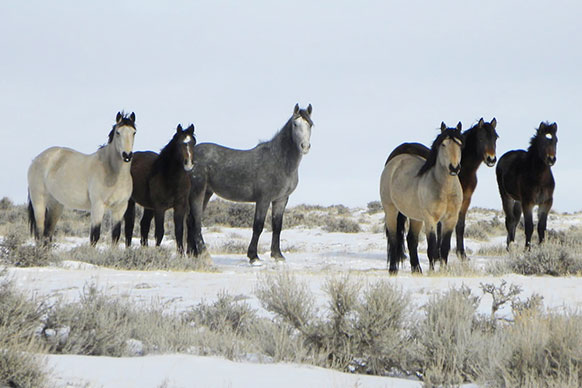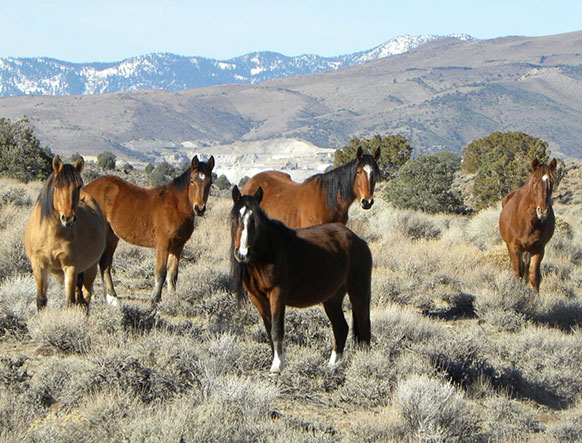
Free-roaming horses remain in good body condition during winter in the Adobe Town area of southern Wyoming. (Courtney Buchanan Photo)
A sweeping University of Wyoming study of wild horses on federal lands across seven
Western states has found that the animals have a high ability to gain nutrition from
a variety of plants and, by so doing, maintain good body condition, even in winter.
The findings could have implications for federal management of those free-roaming
horses in connection with both livestock grazing and wildlife, according to the study
published in the journal Rangeland Ecology & Management.
“Although horses are considered grazers, our study provides evidence that they can
maintain healthy body condition and potentially achieve higher condition while consuming
a variety of plants,” wrote the researchers, including Professor Jeff Beck, of UW’s
Department of Ecosystem Science and Management, and recent Ph.D. graduate Courtney
Buchanan. “This adaptability of horses to use different forage plants could offer
one reason why populations of free-roaming horses are increasing across federal lands
in the western United States.”
Free-roaming horses on Bureau of Land Management and U.S. Forest Service lands in
the West are protected under the Wild and Free-Roaming Horses and Burros Act of 1971.
Local management occurs within 177 BLM herd management areas, each of which has an
established maximum appropriate management level. Over 80 percent of the BLM’s herd
management areas had populations exceeding their appropriate management levels in
2023, and annual growth rates can reach 20 percent per year.
To get a broad look at the diet and body condition of free-roaming horses across the
West, the scientists analyzed horse fecal samples and observed the animals in both
summer and winter on 16 BLM herd management areas in Wyoming, California, Colorado,
Idaho, Nevada, Oregon and Utah. The Wyoming sites were Adobe Town in southern Wyoming,
Green Mountain in central Wyoming and McCullough Peaks in northern Wyoming.
While grasses or grass-like plants were found to be the largest component of horse
diets in most of the study areas, the scientists learned that other plants -- including
forbs and shrubs -- also are consumed by the animals, at higher levels than previously
understood. The researchers also found that free-roaming horses maintained good body
condition across a variety of landscapes and different seasons.

Free-roaming horses thrive in the sagebrush habitat of the Pine Nut Mountains in Nevada. (Courtney Buchanan Photo)
“These animals appear highly adaptable and have demonstrated remarkable ability to
maintain body condition throughout different ecoregions, seasons, herbaceous availability,
and while consuming varied diets,” the scientists wrote.
For cattle grazing, in particular, the new findings confirm previous research showing
a high overlap in grass consumption by free-roaming horses and cattle on federal lands
where grazing permits are granted.
“In herd management areas where these herbivores overlap, more rangeland planning
may be needed to account for increased demand and potential conflict in (grass or
grass-like) forage use,” the researchers wrote.
Likewise, the new study shows that free-roaming horses consume some shrubs from some
of the same plant families that provide winter forage for wildlife, including sage
grouse, mule deer, pronghorn and elk.
“Additional reliance on these plants by free-roaming horses in the winter may create
competition with wildlife species,” the scientists concluded. “Understanding what
free-roaming horses are eating and at what time of the year in specific herd management
areas can help with locally specific rangeland management planning to help mitigate
free-roaming horse conflict and balance multiple uses.”
Other UW researchers who participated in the study were Jared Studyvin, Jonathan Lautenbach, Derek Scasta and Greg Randolph.

